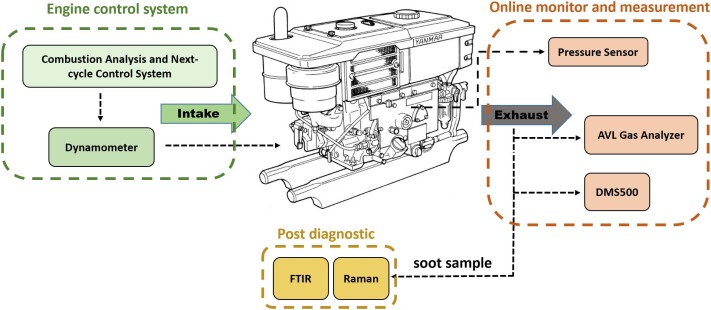Evaluating the effect of n-butanol additive on particulate matter emission in diesel engine
- Systematic experimental study on diesel and n-butanol blends with different ratios.
- 20% n-butanol addition produces the longest ignition delay and longest combustion duration under varying engine conditions.
- N-butanol addition can reduce the PM emission by promoting the premixed combustion and suppling extra oxygen content.
- Raman and FTIR spectra analysis are utilized to study the properties of the soot particles from emission sampling.
- Two injection pressures are used to compare the effect of the injection pressure on different fuel blends.
 In this study, we perform experiments on a common-rail diesel engine to investigate the effect of diesel/n-butanol blends on particulate matter (PM) emission under pilot-main injection strategy. Three different blends (diesel, D80B20, D50B50) are compared under two distinct loads (∼30 %, ∼60 %) and two injection pressures (40 MPa, 60 MPa). Under identical load and injection pressure, the engine fueled with D80B20 has the longest ignition delay and the shortest combustion duration, resulting in the highest HC emissions. The results indicate that the addition of n-butanol can improve the mixing process of fuel and oxidizer and result in a lower mean chamber temperature. The addition of n-butanol can also reduce NOx emission (up to 25 %) because the lower mean chamber temperature caused by the lower heating value of n-butanol tends to reduce NOx emission although there is extra oxygen content in n-butanol. Moreover, the addition of n-butanol can reduce PM emission (up to 69 %) and the engine with D50B50 under low load has the lowest PM emission. We further sample the soot particles from the engine emission. The result of the Raman spectroscopy investigation of soot samples reveals that n-butanol can increase the oxidative reactivity of the particles and the shorter combustion duration of engine can increase the level of disorder of the particles. The result of FTIR spectra shows that the aromatic C=C functional group has the highest signal intensity when the engine is fueled with D80B20 and is diffusion combustion dominated.
In this study, we perform experiments on a common-rail diesel engine to investigate the effect of diesel/n-butanol blends on particulate matter (PM) emission under pilot-main injection strategy. Three different blends (diesel, D80B20, D50B50) are compared under two distinct loads (∼30 %, ∼60 %) and two injection pressures (40 MPa, 60 MPa). Under identical load and injection pressure, the engine fueled with D80B20 has the longest ignition delay and the shortest combustion duration, resulting in the highest HC emissions. The results indicate that the addition of n-butanol can improve the mixing process of fuel and oxidizer and result in a lower mean chamber temperature. The addition of n-butanol can also reduce NOx emission (up to 25 %) because the lower mean chamber temperature caused by the lower heating value of n-butanol tends to reduce NOx emission although there is extra oxygen content in n-butanol. Moreover, the addition of n-butanol can reduce PM emission (up to 69 %) and the engine with D50B50 under low load has the lowest PM emission. We further sample the soot particles from the engine emission. The result of the Raman spectroscopy investigation of soot samples reveals that n-butanol can increase the oxidative reactivity of the particles and the shorter combustion duration of engine can increase the level of disorder of the particles. The result of FTIR spectra shows that the aromatic C=C functional group has the highest signal intensity when the engine is fueled with D80B20 and is diffusion combustion dominated.
- Access the article at the publisher: DOI: 10.1016/j.fuel.2022.126003



